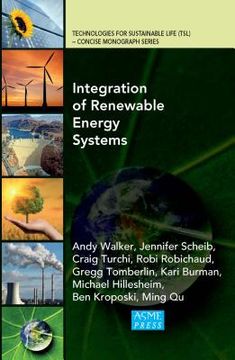Share
Integration of Renewable Energy Systems (in English)
Andy Walker
(Author)
·
Jennifer Scheib
(Author)
·
Craig Turchi
(Author)
·
American Society of Mechanical Engineers
· Hardcover
Integration of Renewable Energy Systems (in English) - Walker, Andy ; Scheib, Jennifer ; Turchi, Craig
$ 99.00
$ 134.36
You save: $ 35.36
Choose the list to add your product or create one New List
✓ Product added successfully to the Wishlist.
Go to My WishlistsIt will be shipped from our warehouse between
Thursday, May 30 and
Friday, May 31.
You will receive it anywhere in United States between 1 and 3 business days after shipment.
Synopsis "Integration of Renewable Energy Systems (in English)"
Energy efficiency measures are generally less expensive than a renewable energy (RE) system to provide the same amount of energy saved. The Energy Information Administration reports that, on average, a dollar spent on efficiency saves $2 off the cost of a renewable energy system to provide the same amount of energy [IEA, 2011]. But as the saying goes "you can't save yourself rich" and having installed sophisticated controls and efficient systems, we need some source of energy to power them. On-site renewable energy systems offer several advantages, especially when operated in concert with a larger utility system. The main reasons to consider RE is cost-effectiveness, but other reasons are as diverse as: reduction of atmospheric emissions; compliance with regulations requiring RE; enhanced reliability through redundant energy supply; abate risks related to fuel availability and cost, or risk of fuel-spills during delivery; score points in a sustainability rating; or as a mitigation measure in a larger environmental-permitting process. Renewable energy technologies used on buildings include daylighting; solar photovoltaics; solar water heating; solar ventilation air preheating; passive solar heating and cooling load avoidance; wind power; biomass heat (or cogeneration as discussed in Chapter 8); anaerobic digestion of waste; and geothermal heat. Ground source heat pumps are also often considered, in-part, RE systems. Daylighting and the envelope measures (passive heating and cooling) are often considered efficiency measures, but daylighting is a direct and obvious use of solar energy in buildings, and photovoltaics (PV), Solar Water Heating and Solar Ventilation Air preheating are technologies to consider on any building project. We even consider an example of hydroelectric power on the water supply to a building. We cover the operating principle of each type of system, list components and provide schematic diagram of how components are assembled into systems; provide information for cost estimate and life cycle cost calculation, describe how system size may be optimized to minimize life cycle cost, and we stress the importance of operations and maintenance (O&M) over a long performance period. Significant emphasis is placed on integration of RE into the conventional utility system, at both the site level and from the perspective of the larger utility system, so that savings due to the RE may be realized without compromising the reliability of the system. Case studies are presented to exemplify application of each technology.
- 0% (0)
- 0% (0)
- 0% (0)
- 0% (0)
- 0% (0)
All books in our catalog are Original.
The book is written in English.
The binding of this edition is Hardcover.
✓ Producto agregado correctamente al carro, Ir a Pagar.

